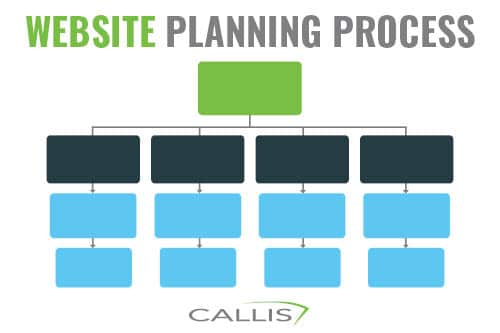The Importance of Planning When Developing a Website

An often overlooked but critical part of the website development process is planning. Before creating a design or writing any code, there should be an in-depth planning process to ensure that the website meets all user needs.
Benefits of including planning early in the website development process:
- Identify all business needs
- Identify all user needs (content and functionality)
- Prevents wasted resources and improves cost-effectiveness
- Builds a better user experience for all audiences
Website Planning Process
At a minimum, the website planning process typically includes two parts.
- Website Discovery
- User Experience (UX) Exercise
Website Discovery
Planning for a website starts with a discovery process including key stakeholders to uncover all necessary information.
- Likes and dislikes of their existing website
- Desired functionality of the new website
- Tools and options that would be ideal to include
- Appearance preferences to inspire the design
- Additional questions that arise during the conversation
This discovery helps establish what a new website needs to include to achieve the desired objectives. The time to complete the initial discovery depends on the size and complexity of a website, but the time is a worthwhile investment.
After completing the initial discovery, we move on to the UX exercise.
Website User Experience (UX) Exercise
The user experience exercise is a deeper dive into the website audiences and how they will interact with the website. The first step is to identify and prioritize all the website audiences. This helps to uncover users you might not normally consider and hone in on the most important audiences.
Then we will identify what each audience needs from the website. During this process, it is important to consider how different audiences need different things. Once we have all the needs documented, we can go through the process of building out a rough website structure that communicates effectively with all audiences.
Visualizing and working through this process can be difficult so we take an interactive approach that includes building out the website structure with pieces of paper on a wall. This helps to visualize the structure, lets us move users through the site page by page and gives us the flexibility to restructure it as needed.
The information collected during this process helps to determine the different needs of all users and build those considerations into the website structure and functionality. This ensures that the entire site flows well to meet the needs of all users.
Additional Website Planning Tasks
If the website is larger or more complex, additional planning steps may be included to pinpoint potential problems and develop solutions to these problems. Additional tasks or exercises may include:
- Focus Groups
- Develop Personas
- Analyze Additional Data
Focus Groups
For some websites, it may be beneficial to conduct focus groups. Focus groups allow you to test the user experience, validate assumptions you may have or uncover potential opportunities or issues directly from the customer. Depending on the specific need and issue, focus groups can be conducted at different points in the planning process.
Develop Personas
Personas help you understand who is interacting with your brand, what they are searching for and how you can meet their needs. This makes them a great resource to have when developing a website. They can be used to help guide decisions throughout the planning process and help with developing content and other marketing materials.
Analyze Additional Data
This step will vary greatly from company to company as it is driven by the data that you have available or need. If you currently have a website, reviewing the analytics, heatmap and other data from website optimization tools could provide you with clues about current pain points and help identify opportunities to improve. Any first-party data or research that has been collected should be also be reviewed for additional insights. Surveys are another valuable tool if you have specific questions that could be answered from customer feedback.
When developing a website, building a strong foundation is vital. Having a plan based on data and strategy sets the tone for the project moving forward. A discovery and UX exercise ensures that all functionality is included, all audiences are considered and that the website is developed cost-effectively and efficiently. This results in a website that meets your needs and serves as a great first impression when customers view your website online.

